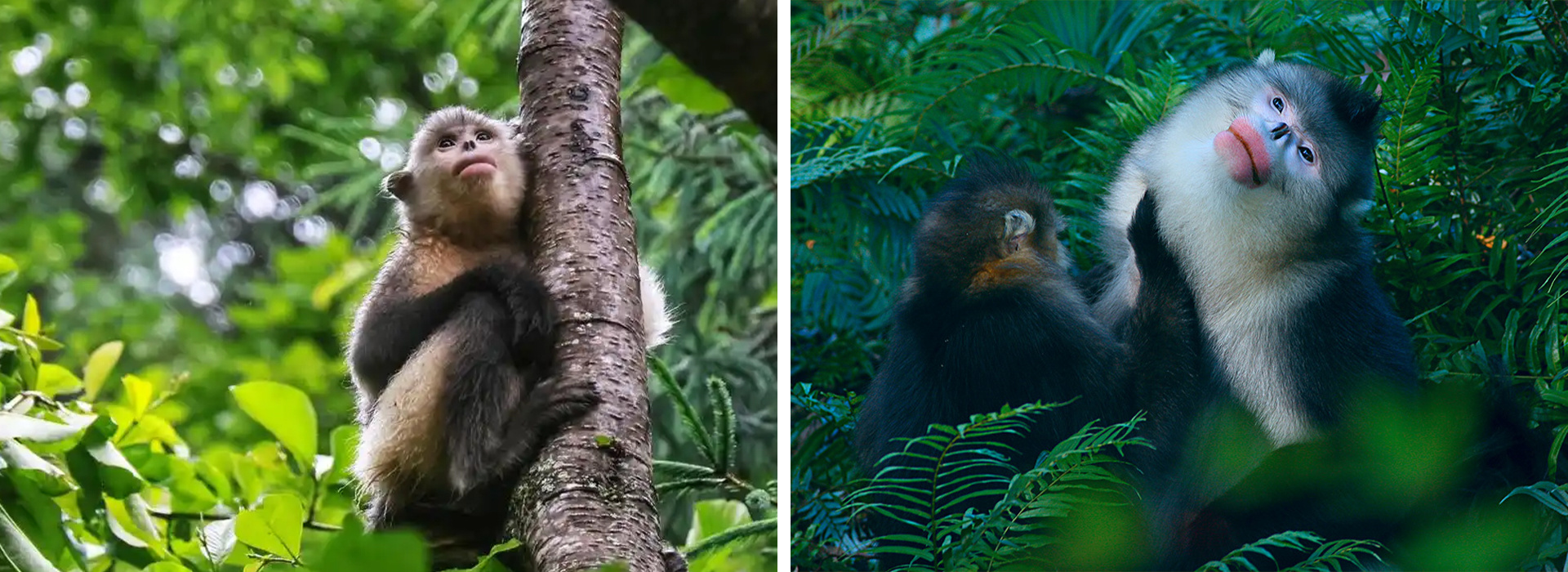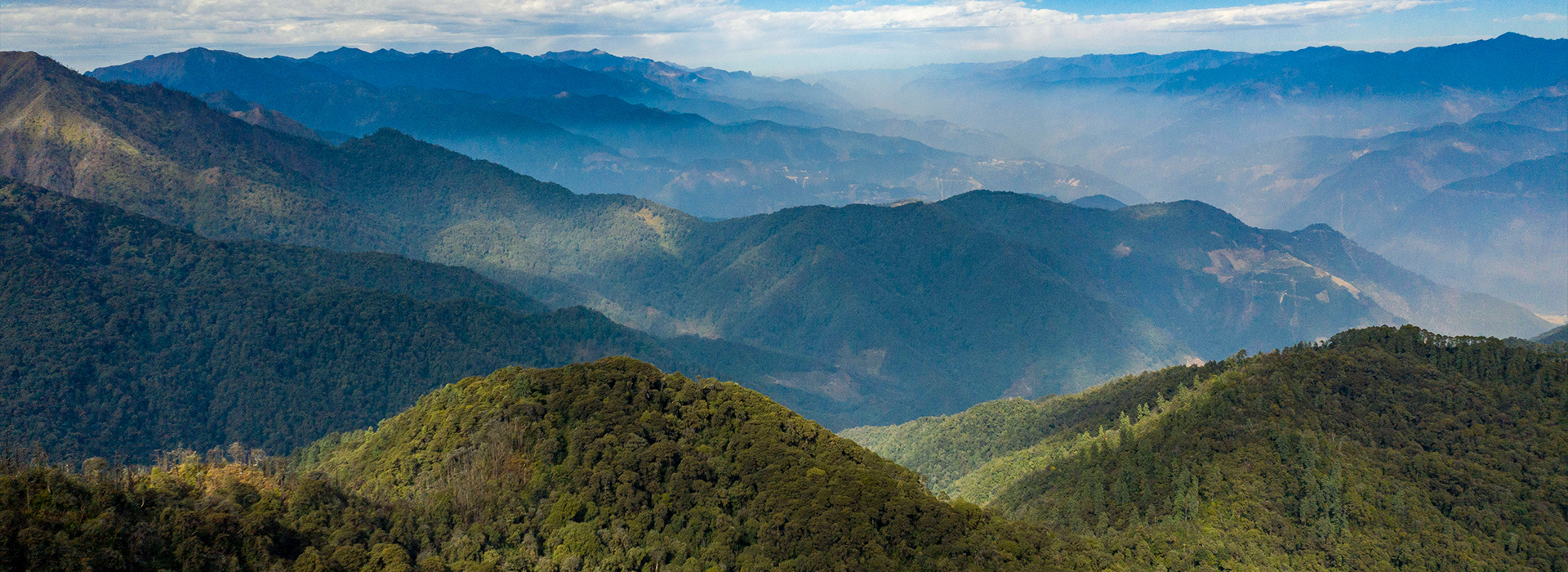Yunnan snub-nosed monkey national park
The Shangri-La Yunnan Golden Monkey National Park is located in Tacheng, the "Reba Art Village" on the western ring road of Shangri-La tourism. It is 70 kilometers from Weixi County, 120 kilometers from Shangri-La, the prefectural capital, and 120 kilometers from Lijiang City. The construction of the park was proposed at the Yunnan Provincial Tourism Industry Conference on June 22, 2007, and the construction of the park began. On September 22, 2009, the first phase of the park's construction was completed and officially put into use. The park is located in the heart of the "Three Parallel Rivers", covering an area of 334.16 square kilometers. Its scope is: east to Qizong along the Jinsha River southward to the border of Lijiang Yulong Naxi Autonomous County; west along the watershed to the northwest of the Darmo Patriarch Cave to the border of Deqin County; south to La Ji Ding Village southwest of Haini Village; north to the border of Deqin County north of the upper reaches of Xiangguqing. It is one of the "three" national parks in Diqing Prefecture, with abundant tourism resources: a total of seven sub-categories, thirty basic types, and more than seventy resource entities, involving geology and geomorphology, ice and snow waters, rare animals and plants, ethnic customs, and multi-religious cultures. The main scenic spots in the park include: Xiangguqing Wildlife Rescue Station (observing wild Yunnan snub-nosed monkeys in the designated area), Darmo Patriarch Cave, a Buddhist holy land, Qizong Divine Spring, Qibie Millennium Ginkgo Tree, Gordon Neolithic Cultural Site, the First Stone Gate of the Yangtze River, and Duona Pavilion Lisu Village, etc.

I. Scenic Spots
1. Xiangguqing Wildlife Rescue Station: The altitude is 2800-3100 meters, the planned area is 810 hectares, and the wild Yunnan snub-nosed monkey viewing area is about 60 hectares. This area mainly focuses on observing wild Yunnan snub-nosed monkeys, and many national rare animals and plants can also be seen in this area. National rare plants: Yulongjue, single-leaf grass, Yunnan yew, Torreya, etc.; secondary plants include Jintiesuo, oil-pressed fir, etc. It is also home to many national first-class protected animals: clouded leopards, golden eagles, etc., and second-class protected animals: black bears, macaques, golden pheasants, etc.
In this area, you can see the Yunnan snub-nosed monkey, a national first-class protected rare animal comparable to the giant panda. They have a human-like face and are a red-lipped species among primates other than humans. The reason why it is rare is that it is a primate animal in China, with a narrow distribution area, near the snow line at an altitude of 2800-4300 meters in the Yunling Mountains between the Jinsha River and the Lancang River. It occupies a special taxonomic position between Old World monkeys and apes in phylogenetic terms, so the study of Yunnan snub-nosed monkeys is of great significance to people's understanding of the evolutionary process of human beings. It is considered by zoologists to be a specialized animal with high academic research value.
2. Buddhist Holy Land - Darmo Patriarch Cave:
"Looking far, cliffs are thousands of feet high, and majestic ancient temples reach the sky." The Patriarch Cave is embedded in the thousands of feet high cliff of Mount Darmo. Looking up at Mount Darmo, it is like a serene seated Buddha. Darmo Temple was built in 1151 AD as a meditation retreat for the Patriarch Cave, with stone steps extending into the cave.
Legend has it that Darmo Patriarch practiced meditation in the cave for ten years and attained enlightenment. To this day, there are still traces of Darmo Patriarch's "turning stone into a depression" in the cave. To the left of Mount Darmo is Laiyuan Temple and a vast primeval forest, with many precious medicinal plants and animals. The Darmo Patriarch Cave is very famous in the Kamba area. Every year on the first day of the fourth lunar month, which is said to be the anniversary of Darmo Patriarch's enlightenment, countless pilgrims come to pay homage, even attracting pilgrims from overseas. Thousands of pilgrims gather, eating and sleeping outdoors, bustling with activity, shaking prayer wheels, rolling prayer beads, and circumambulating the mountain continuously. The scene is spectacular, also known as the "Circumambulation Festival".
3. Qibie Millennium Ginkgo Tree:
Qibie Village in Tacheng Town is a village where the Naxi people live. There is a tall and straight, lush ginkgo tree here, 39 meters high and 200 centimeters in diameter. According to research, the tree is over a thousand years old and has been praised by botanists as the "Millennium Ginkgo Tree". Legend has it that a Tubo monk planted a tree in three different areas to find the reincarnation of a previous life Buddha. Only this tree survived the following year, so there have been many reincarnations of the Buddha in this place, and this tree has thus become a sacred tree and is worshipped by the local people.
4. Qizong Divine Spring:
The Divine Spring is about 400 meters from Qizong Village. Standing in front of the Qizong power station and looking west, a green tributary of the Jinsha River and towering green mountains are together. The source of the Divine Spring has abundant water flow, stable water source, and crystal-clear water. Ancient trees stand tall by the river, with oak trees forming a forest; the straight-line distance to the confluence with the Jinsha River is only 150 meters. It is a must-visit place for tourism in Weixi and a place of pilgrimage for local people.
5. The First Gate of the Yangtze River - Shimenguan:
The Jinsha River, flowing from north to south, is blocked and turns northeast, then splits a channel to the south and continues to flow south. This is the historically famous First Stone Gate of the Yangtze River. Historical records state that the Tang and Nanzhao armies "defeated Tubo, exited Shimenguan, and all those who passed surrendered," showing the important strategic position of Shimenguan in military affairs at that time. Thirteen hundred years ago, Tubo built the world's earliest iron bridge here. Eight hundred years ago, the Yuan army crossed the river here from "Gengnang," eliminating the Dali Kingdom and establishing the Shenchuan Dudufu here.
6. Duona Pavilion Lisu Village:
Duona Pavilion is located in Tacheng Town, Weixi Lisu Autonomous County. The village is backed by mountains and faces water, surrounded by dense primeval forests. With 70 households and nearly 300 people, it is a typical Lisu settlement. The village still retains its original rich songs and dances and customs, including the custom of "walking marriage." It is a harmonious Shangri-La world of people and nature.

II. Ethnic Culture and Customs
1. Tacheng Tibetan Reba Dance:
The Reba dance originated in the eleventh century and is widely spread in Diqing. The Tacheng Tibetan Reba dance, "Shenchuan Reba," has a long history and retains its classical style relatively completely, and is considered the orthodox Reba dance. It is a combination of singing, dancing, monologue, and instrumental music. It is usually performed during the Tibetan New Year, religious festivals, and in the event of droughts, floods, or plagues. During the performance, men hold copper bells and women hold hand drums (hence the Reba dance is also known as the bell and drum dance), moving in circles and dancing gracefully.
2. Marima Sa - Speaks Five Languages
This is a self-proclaimed ethnic group called Marima Sa. Their architecture, language, and customs are unique, and there is no clear classification for them in ethnology yet. Tacheng is a place where many ethnic groups live together. Due to the need for communication, there is a Marima Sa who speaks five languages: Chinese, Tibetan, Lisu, Dongba, and Marima Sa.
3. Achi Mugua
"Achi Mugua" is a folk dance for entertainment, prevalent in the upper reaches of the Lancang River, centered around Yezhi Township. The dance's origin and form are related to the Lisu people's semi-pastoral, semi-agricultural lifestyle and their fondness for raising goats. Its characteristic is that it doesn't use musical instruments; people sing and dance from beginning to end. The dance is generally divided into six parts. Its melody can be slow or fast, with frequent rhythmic leaps and a wide range of pitch, giving a feeling of ease and freedom. The Lisu people believe in gods and ghosts, etc., of primitive religions, but they have no temples. Religious activities are mostly carried out through the performance of the dance "Achi Mugua".
Achi Mugua is an important part of the lives of the Lisu people and has been included in the "Compendium of Chinese Ethnic Songs and Dances" as a folk song and dance with high artistic value.
Scenic Area Grade: 3A




 Wechat Official Account
Wechat Official Account